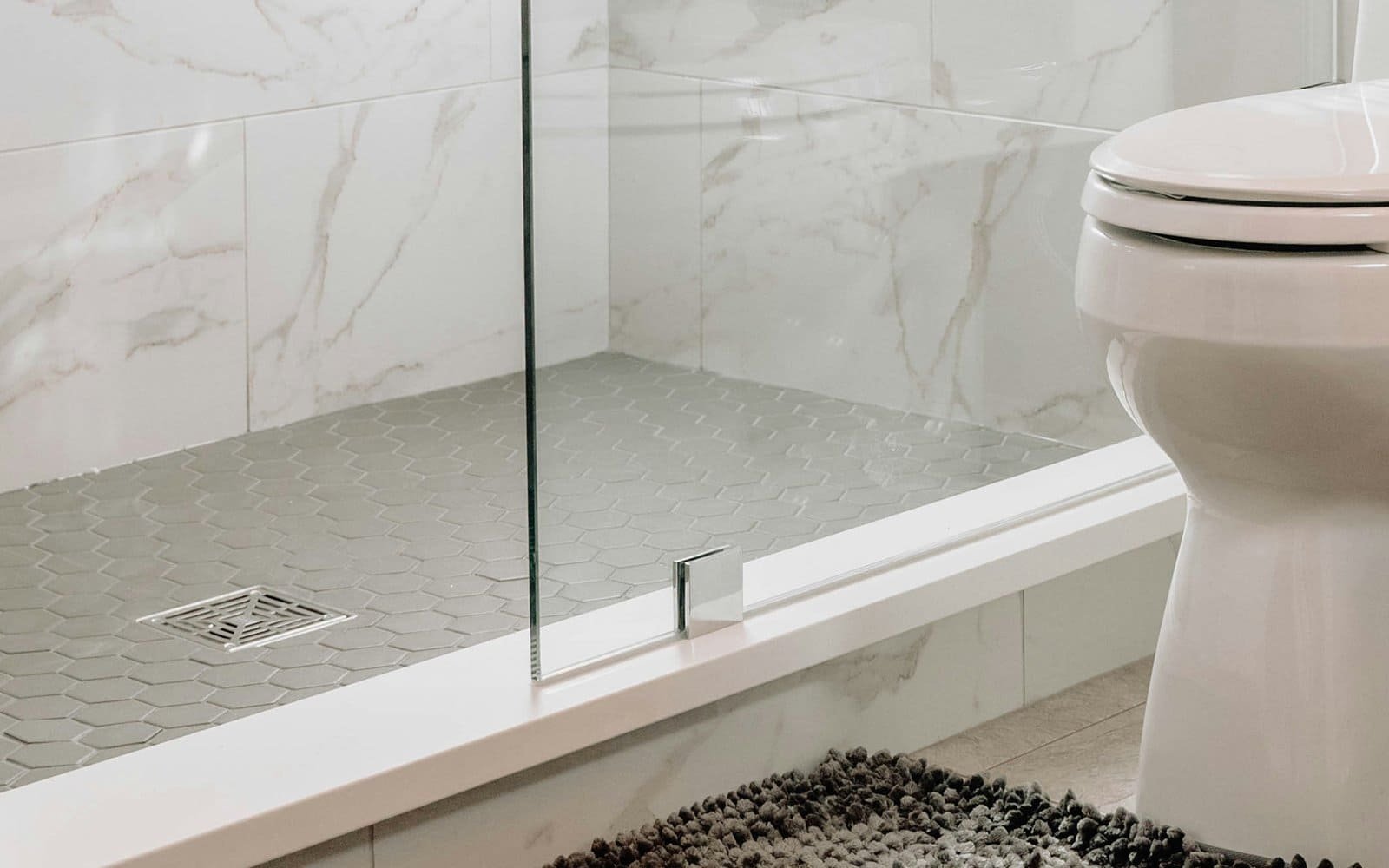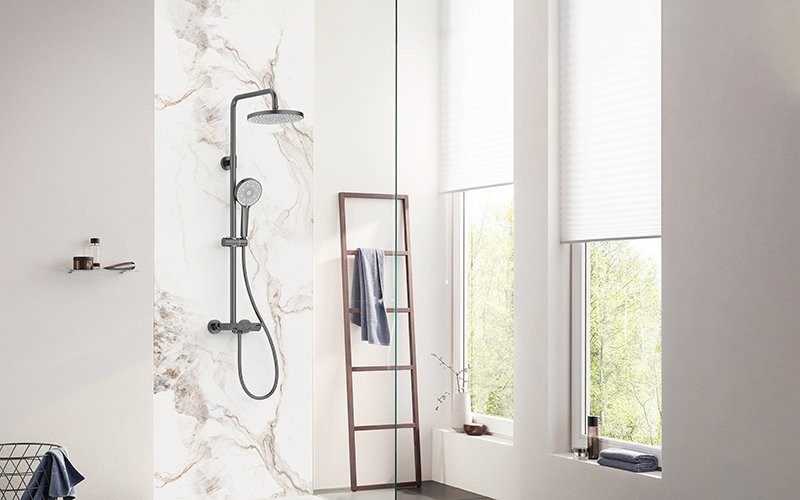Table of Content

Introduction: More Than Just a Drain
Your shower drain is more than just a hole for water to escape. It’s a critical component that impacts your bathroom’s safety, function, and style.
The right drain prevents water from pooling, which reduces slip hazards and protects your home from water damage. It can also be a subtle design feature that ties the room together.
This guide covers the essentials: drain types, materials, finishes, and proper installation, so you can choose the perfect drain with confidence.
The Two Core Designs: Linear vs. Point Drains
Shower drains fall into two main categories: point drains and linear drains. Your choice will affect your shower floor’s construction, your tile options, and the final look of your space.
Point Drains: The Traditional Choice
This is the classic shower drain. It’s usually a square or round grate located in the center of the shower floor. For it to work, the floor needs to slope towards the drain from all four sides, like a shallow funnel.
- Best For: Traditional bathrooms, smaller showers, and projects on a tighter budget.
- Tile Compatibility: The multi-directional slope works best with small tiles, like mosaics (4×4 inches or smaller), that can easily follow the floor’s contours.
Linear Drains: The Modern Solution
Linear drains are long, rectangular channels that offer a clean, contemporary look. They are typically installed against a wall or at the shower entrance. Their biggest advantage is that the floor only needs to slope in one direction.
- Best For: Modern designs, large walk-in showers, and creating an accessible, barrier-free entry.
- Tile Compatibility: The single slope is perfect for large-format tiles and stone slabs. This creates a seamless look with fewer grout lines, making the space feel bigger.
Tile-In Drains: The Invisible Option
For a truly minimalist look, both drain types are available in a “tile-in” style. This design lets you place a piece of your floor tile into the drain grate, making it blend in seamlessly with the floor. Water flows discreetly around the edges of the tile insert.
Material Matters: Choosing for Durability
A drain’s material determines how long it will last and how well it resists corrosion.
Common Drain Materials
- Stainless Steel: The most popular choice for its durability, corrosion resistance, and modern look.
- Brass: A highly durable and corrosion-resistant material with a classic look and natural antimicrobial properties.
- Plastic (ABS/PVC): A budget-friendly option, but it’s less durable than metal.
A Deep Dive into Stainless Steel: 304 vs. 316 Grade
When choosing stainless steel, the grade is critical for long-term performance.
304 Grade Stainless Steel
This is the industry standard for a reason. Often called 18/8 stainless steel, it contains 18% chromium and 8% nickel. For most indoor bathrooms, 304 grade provides fantastic corrosion resistance and is a great value.
316 Grade Stainless Steel
316 grade adds 2-3% molybdenum to the 304 formula. This key ingredient dramatically increases its resistance to corrosion from salt and chlorine.
Which Grade is Right for You?
- Choose 304 Grade for: Most standard indoor home and commercial bathrooms. It offers more than enough protection for daily use.
- Choose 316 Grade for: Harsher environments. This is the best choice for outdoor showers, homes in coastal areas, or installations near swimming pools where salt and chlorine are present.
The Finishing Touch: Style and Durability
The finish affects both the look of your drain and its resistance to daily wear and tear.
Polished Chrome
A timeless, mirror-like finish created by electroplating. It’s durable and budget-friendly. The downside? It shows water spots and fingerprints easily, so it needs frequent wiping.
Matte Black
A popular choice for modern bathrooms, matte black is great at hiding fingerprints. However, it can show dust, may be scratched during installation, and requires gentle, non-abrasive cleaners. This finish can be created with powder coating, electroplating, or a more durable PVD process.
The PVD Advantage
Physical Vapor Deposition (PVD) is an advanced finishing process, not a color. It bonds the finish to the metal at a molecular level, making it exceptionally resistant to scratches, corrosion, and tarnishing. Finishes like Brushed Nickel and high-end Matte Black use PVD for superior durability.
Critical Installation Considerations
A great drain is useless without proper installation. While a professional should handle the job, you should discuss these key points with your installer.
Match the Flow Rate
Your drain must handle the water from all your shower fixtures at once—showerhead, hand shower, body sprays, etc. A standard drain handles about 9 gallons per minute (GPM), but a high-volume system needs a high-flow drain.
Ensure Plumbing Compatibility
The drain’s outlet size and material must match your home’s waste pipe (e.g., a PVC drain for a PVC pipe system).
Prioritize Waterproofing
This is the most important step. A waterproof membrane must be installed correctly across the shower floor and sealed to the drain’s flange to prevent leaks and water damage.
Verify the Floor Slope
The shower floor must slope towards the drain at a rate of 1/4-inch per foot. This ensures water flows away efficiently and doesn’t create puddles.
Long-Term Care and Maintenance
A little maintenance goes a long way in keeping your drain working perfectly
Clean Regularly
Once a week, lift the cover and clear out any hair or soap scum. A drain strainer or hair catcher is the best way to prevent clogs from forming in the first place.
Use Safe Cleaning Solutions
For a monthly deep clean, pour one cup of baking soda down the drain, followed by one cup of white vinegar. Let it fizz for 15-20 minutes, then flush with hot water. Avoid harsh chemical cleaners, which can damage pipes and certain finishes.
Address Deeper Clogs
For stubborn clogs, a plunger or a plumbing snake often works. If you can’t clear it yourself, call a professional plumber to avoid causing bigger problems.
Conclusion
Choosing a shower drain comes down to balancing style, function, and budget. Whether you prefer the modern, seamless look of a linear drain or the classic, budget-friendly appeal of a point drain, the right option is out there.
Pay close attention to the material—like choosing 316 stainless steel for coastal homes—and select a finish that matches your other fixtures.
Most importantly, proper installation and waterproofing are non-negotiable for a long-lasting, leak-free shower. With this knowledge, you’re ready to select a drain that not only works perfectly but also enhances the beauty of your bathroom for years to come.
Related Posts








